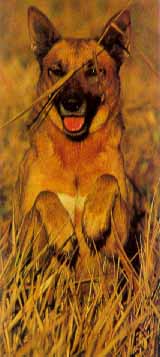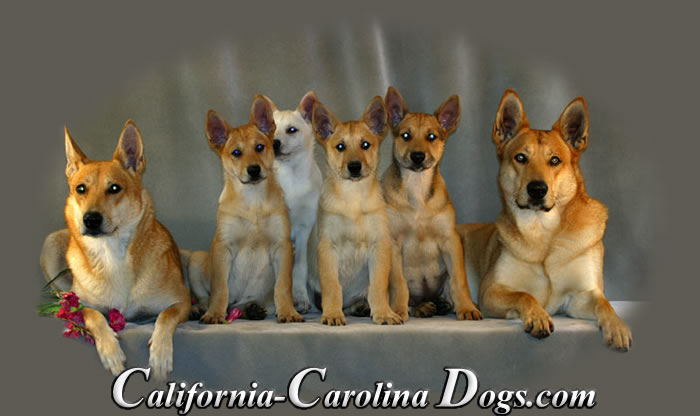“Tracking America's Native Breed”
Copyright 1999 Smithsonian Magazine
All photos by Lynda Richardson
ARTICLE PAGE 1 2 3 4 5
 AMERICA - It's not often that a registered breed of dog starts with a castoff that even the pound didn't want and a stray plucked out of the woods. But it is even less likely that such animals would provide one of those rare “Eureka!” moments in science, drawing back the curtain on both evolution and human culture, and providing clues to the mysterious origins of the long, fruitful partnership that exists between humans and canines.
AMERICA - It's not often that a registered breed of dog starts with a castoff that even the pound didn't want and a stray plucked out of the woods. But it is even less likely that such animals would provide one of those rare “Eureka!” moments in science, drawing back the curtain on both evolution and human culture, and providing clues to the mysterious origins of the long, fruitful partnership that exists between humans and canines.
And yet, that's exactly what happened with the shy enigma of a creature known as the Carolina dog, which just may be a remnant of the first animals to accompany humans across the Bering land bridge to North America thousands of years ago. Then again, it may be nothing more than a modern mutt; no one is exactly sure, and the genetic evidence, while suggestive, is thus far inconclusive. Regardless, the Carolina dog, and several other demonstrably primitive canids, some nearing extinction, are part of a controversial reexamination of how modern dogs arose, and even more fundamental questions about the process of domestication itself.
If you passed a Carolina dog on a back road in humid South Carolina Low Country, where stands of tall longleaf pine alternate with crop fields and cypress swamps, chances are you wouldn't spare it a glance-- it would seem to be just a scrawny, medium-sized mongrel with a reddish-yellow coat, upright ears and a whiplash tail curling up over its back, what rural Southerners have long called a "yaller" dog. And for years, that's all I. Lehr Brisbin, Jr., thought they were, too.
Brisbin-- "Bris" to his colleagues at the Savannah River Ecology Lab (SREL) in Aiken, South Carolina-- saw these skittish feral dogs from time to time.
Brisbin is a senior ecologist on the sprawling Savannah River Site, a huge nuclear reservation carved out of the local farmland in the 1950s by the federal government, which built reactors there for the defense program. The reactors are shut down now, and the Savannah site-310 square miles of mostly forest and wetlands-is a National Environmental Research Park. Fenced off with barbed wire and closed to the public, it is a fertile haven for wildlife despite some areas with residual radioactivity.
 Brisbin, a trim man in his late 50s with bottomless energy, is a polymath with professional interests that range from alligators and box turtles to wood storks and furbearers. His graduate work on the bioenergetics of reptiles and birds first led him to study red junglefowl, the ancestors of modern chickens. And that sparked a curiosity about the process of domestication in animals, which in turn meshed neatly with his lifelong passion for dogs and dog training.
Brisbin, a trim man in his late 50s with bottomless energy, is a polymath with professional interests that range from alligators and box turtles to wood storks and furbearers. His graduate work on the bioenergetics of reptiles and birds first led him to study red junglefowl, the ancestors of modern chickens. And that sparked a curiosity about the process of domestication in animals, which in turn meshed neatly with his lifelong passion for dogs and dog training.
And that led him, eventually, to Horace and Marion. Horace was a stray, white with brown markings, found wandering in the late '70s on the boundary of the Savannah River Site. There wasn't anything terribly special about him- he seemed just a typical rural mutt of the sort you'd find chained to back porches and doghouses from the Carolinas to Texas. Brisbin, whose specialty at the time was training American Staffordshire terriers and bloodhounds, added Horace to his kennel of show dogs, and for several years didn't spare him much more thought.
Which is a little odd, because Brisbin was beginning to think about feral dogs. Early in his research on domestication, he became fascinated by the origins of truly wild dogs, like the dingo in Australia, a honey-gold dog believed to have come to the island continent with humans about 4,000 years ago. He wondered whether the dogs that came to North America with humans might have been similar to dingoes, and he studied the archaeological and anthropological evidence. And he spent his spare time learning about the so-called pariah dogs of the Old World, which share traits with dingoes.
In many corners of Europe, Asia and Africa, on the margins of human civilization, there are dogs lurking in the shadows-not pampered house pets, but untamed, often malnour ished animals scavenging for scraps and garbage, avoiding people, surviving on the edge between wild and tame. Regardless of the setting-Afghanistan, Korea, Malaysia, the Papua New Guinea highlands-they frequently share common attributes: shorthaired coats that may be multi-colored but are often ginger, curled tails, erect ears and foxlike faces. In India these animals are called pariahs, after the low-ranking social caste, and that name has come to be applied to such populations elsewhere.
In fact, Brisbin has defined a "pariah niche," a pervasive canine lifestyle that revolves around scavenging garbage near human settlements. One winter day several years after Horace arrived, Brisbin had him out f'or a run with his other, pedigreed dogs. That day, for some reason, Brisbin looked beyond Horace's piebald coat to his shape and proportions, and it struck him that the dog looked just like a dingo, like the pariahs halfway around the world. "At that moment everything just fell into place," he says now, 20years later.
Brisbin realized that he'd been seeing dogs that looked like dingoes for years, roaming the woods of the Savannah River Site, often turning up in the traps he'd set as part of his regular forbearer surveys. On a hunch, he drove that day to an animal shelter just to see if they had more of these dingo-like dogs.
NEXT PAGE